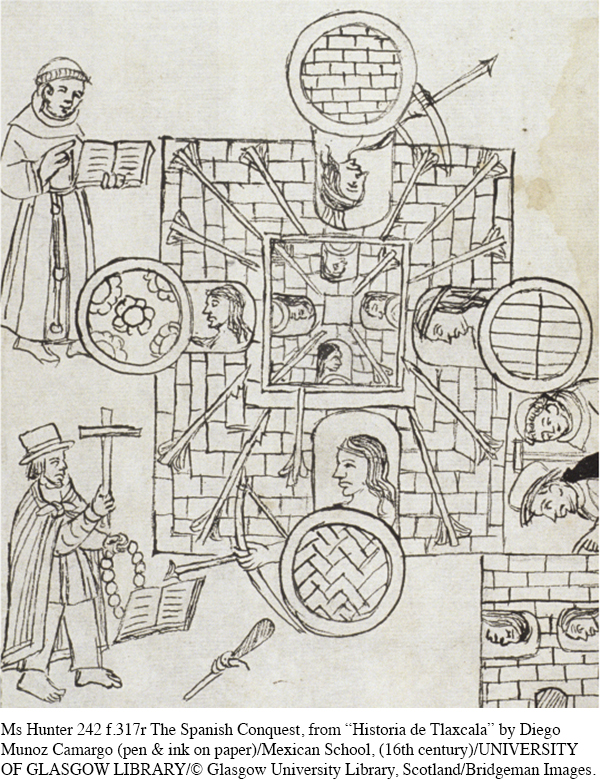The American Promise: Printed Page 36
The American Promise, Value Edition: Printed Page 35
The American Promise: A Concise History: Printed Page 41
The Search for Other Mexicos
Lured by their insatiable appetite for gold, Spanish conquistadors (soldiers who fought in conquests) quickly fanned out from Tenochtitlán in search of other sources of treasure. The most spectacular prize fell to Francisco Pizarro, who conquered the Incan empire in Peru. The Incas controlled a vast, complex region that contained more than nine million people and stretched along the western coast of South America for more than two thousand miles. In 1532, Pizarro and his army of fewer than two hundred men captured the Incan emperor Atahualpa and held him hostage. As ransom, the Incas gave Pizarro the largest treasure yet produced by the conquests: gold and silver equivalent to half a century’s worth of precious-
Juan Ponce de León sailed to Florida in 1521 to find riches, only to be killed in battle with Calusa Indians. A few years later, Lucas Vázquez de Ayllón explored the Atlantic coast north of Florida to present-
The American Promise: Printed Page 36
The American Promise, Value Edition: Printed Page 35
The American Promise: A Concise History: Printed Page 41
Page 37In 1539, Hernando de Soto, a seasoned conquistador, set out with more than six hundred men to find another Peru in North America. Landing in Florida, de Soto slashed his way through much of southeastern North America for three years. De Soto typified the viewpoint of other conquistadors when he told an Indian leader in Georgia that he “was the child of the Sun, coming from its abode, and that he was going about the country seeking the greatest prince there and the richest region.” After the brutal slaughter of many Native Americans and much hardship, de Soto died in 1542. His men buried him in the Mississippi River and turned back to Mexico, disappointed.
The American Promise: Printed Page 36
The American Promise, Value Edition: Printed Page 35
The American Promise: A Concise History: Printed Page 41
Page 38Tales of the fabulous wealth of the mythical Seven Cities of Cíbola also lured Francisco Vásquez de Coronado to search the Southwest and Great Plains of North America. In 1540, Coronado left northern Mexico with more than three hundred Spaniards, a thousand Indians, and a priest who claimed to know the way to what he called “the greatest and best of the discoveries.” Cíbola turned out to be a small Zuñi pueblo of about a hundred families. When the Zuñi shot arrows at the Spaniards, Coronado attacked the pueblo and routed the defenders after a hard battle. Convinced that the rich cities must lie somewhere over the horizon, Coronado kept moving all the way to central Kansas before deciding in 1542 that the rumors he had pursued were just that.

The same year Coronado abandoned his search for Cíbola, Juan Rodríguez Cabrillo’s maritime expedition sought to find wealth along the coast of California. Cabrillo died on Santa Catalina Island, offshore from present-
These probes into North America by de Soto, Coronado, and Cabrillo persuaded other Spaniards that although enormous territories stretched northward from Mexico, their inhabitants had little to loot or exploit. After a generation of vigorous exploration, the Spaniards concluded that there was only one Mexico and one Peru.